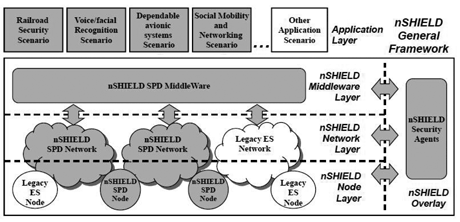by Mariana Esposito, Andrea Fiaschetti, Francesco Flammini
New SHIELD (nSHIELD) is a European research project co-funded by the Artemis Joint Undertaking (Sub-programme SP6) focused on the research of innovative solutions for security, privacy, dependability (SPD) in the context of embedded systems (ES), including those employed in railway security applications.
The nSHIELD project aims at addressing SPD issues as “built in” rather than as “add-on” functionalities, by adopting an innovative holistic approach. We perceive this strategy as being the first step towards SPD certification for future ES.
The leading ideas at the basis of this research are: i) to enrich the state-of-the-art with new SPD solutions and ii) to enable the composability of these (new or already existing) solutions. This will be achieved in two steps. First, starting from current SPD solutions, the project will develop new technologies and consolidate those already explored in pSHIELD (a SHIELD pilot project) in a solid basement that will become the reference milestone for a new generation of “SPD-ready” ES. Second, these technologies will be then enhanced with the “composability” functionality that is being studied and formalized.
In a nutshell, composability is the possibility of dynamically activating one or more SPD functionalities in order to achieve a desired SPD level. This is possible with the implementation of the following enabling mechanisms and technologies:
- Semantic description of security domain and system components, in order to have a machine-understandable language to drive the automatic composition.
- SPD Metrics, in order to quantify the security needs and the achieved security level over heterogeneous environments
- Security Agent, the engine is in charge of continuously monitoring the environment to look for new components or new security needs
- Policies and control algorithms to provide a solution for the “composition problem”, ie how to put together the available SPD technologies in order to achieve the security target.
nSHIELD will approach SPD at 4 different levels: node, network, middleware and overlay (see Figure 1). For each level, the state of the art in SPD of individual technologies and solutions (ranging from hardware and communication technologies to cryptography, middleware, smart SPD applications, etc.) is expected to be significantly improved and integrated into the so-called SHIELD architectural framework, which will represent the breakthrough result of the project.

The nSHIELD consortium comprises 6 manufacturers and system integrators, 7 universities, 9 SMEs and 2 Industrial R&D organizations, mostly members of ARTEMISIA, the European community of experts in the Embedded Security domain. The project is led by an industrial partnership (70% of the effort) although the universities and research centres involved in the project have an important role (30%) in contributing the needed innovation.
The main objective of the project is to conceive and design an innovative, modular, composable, expandable and high-dependable architectural framework. nSHIELD will achieve the desired SPD level in the context of integrated and interoperating heterogeneous services, applications, systems and devices, and will develop concrete solutions capable of achieving this objective in specific application scenarios with minimum engineering effort. Four scenarios have been carefully selected in order to cover a wide and significant range of expected industrial needs.
One of these scenarios addresses dependable surveillance systems for rail-based transit security, but the aim is to extend applicability also to safety-critical (the so-called “vital”) subsystems in railway signalling, control and supervision. In these contexts, the composability of the SHIELD architectural framework will have great impact on the system design costs and time to market of new products and solutions. At the same time, the integrated use of SPD metrics in the framework will impact on the development cycles of SPD in ES because the qualification, (re-)certification and (re-)validation process of a SHIELD framework instance will be faster, easier and widely accepted.
Link: http://www.newshield.eu/
Please contact:
Mariana Esposito, University of Naples, Italy
E-mail:
Andrea Fiaschetti, University of Rome, Italy
E-mail:
Francesco Flammini, Ansaldo-STS, Italy
E-mail:











